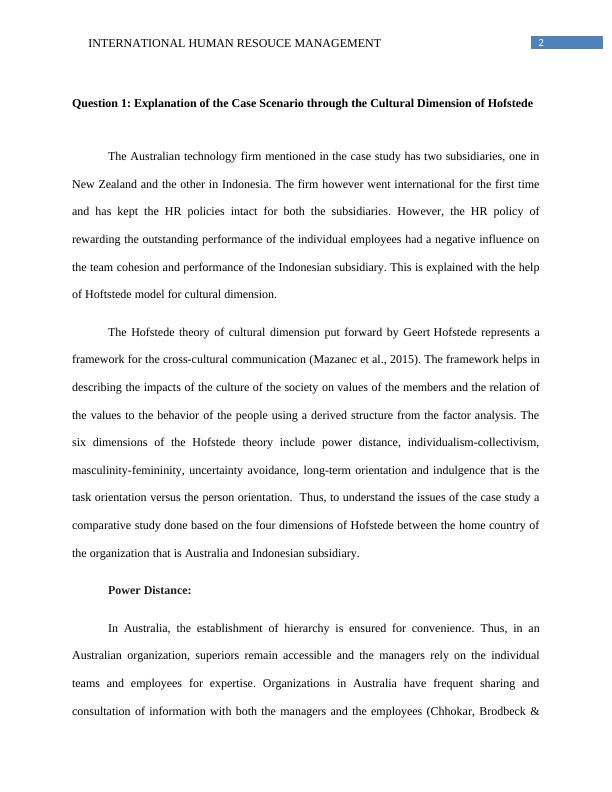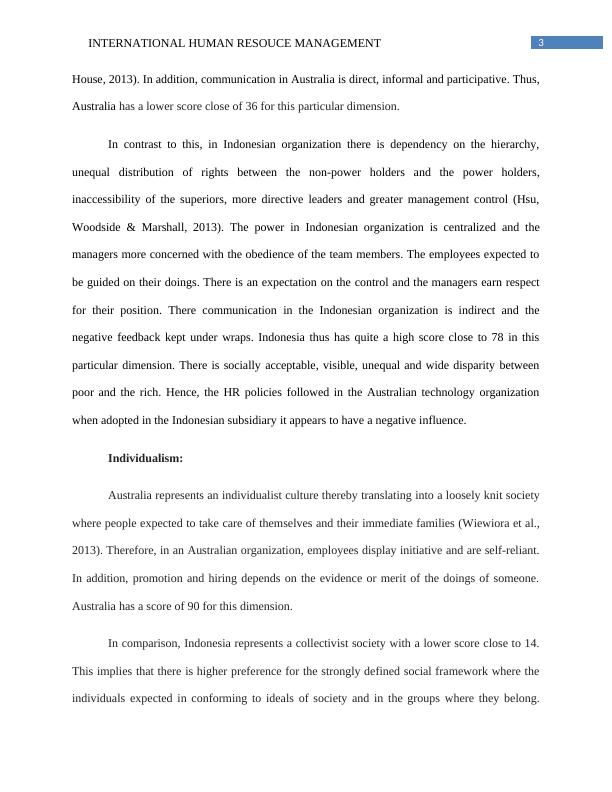(pdf) International Human Resource Management (pdf)
Added on 2021-06-16
12 Pages2611 Words49 Views
Running head: INTERNATIONAL HUMAN RESOUCE MANAGEMENTInternational Human Resource ManagementName of the Student:Name of the University:Author Note:

1INTERNATIONAL HUMAN RESOUCE MANAGEMENTTable of ContentsQuestion 1: Explanation of the Case Scenario through the Cultural Dimension of Hofstede.........2Question 2: Recommendations on Addressing the Issue.................................................................7References:......................................................................................................................................9

2INTERNATIONAL HUMAN RESOUCE MANAGEMENTQuestion 1: Explanation of the Case Scenario through the Cultural Dimension of HofstedeThe Australian technology firm mentioned in the case study has two subsidiaries, one inNew Zealand and the other in Indonesia. The firm however went international for the first timeand has kept the HR policies intact for both the subsidiaries. However, the HR policy ofrewarding the outstanding performance of the individual employees had a negative influence onthe team cohesion and performance of the Indonesian subsidiary. This is explained with the helpof Hoftstede model for cultural dimension. The Hofstede theory of cultural dimension put forward by GeertHofstede represents aframework for the cross-cultural communication (Mazanec et al., 2015). The framework helps indescribing the impacts of the culture of the society on values of the members and the relation ofthe values to the behavior of the people using a derived structure from the factor analysis. Thesix dimensions of the Hofstede theory include power distance, individualism-collectivism,masculinity-femininity, uncertainty avoidance, long-term orientation and indulgence that is thetask orientation versus the person orientation. Thus, to understand the issues of the case study acomparative study done based on the four dimensions of Hofstede between the home country ofthe organization that is Australia and Indonesian subsidiary. Power Distance: In Australia, the establishment of hierarchy is ensured for convenience. Thus, in anAustralian organization, superiors remain accessible and the managers rely on the individualteams and employees for expertise. Organizations in Australia have frequent sharing andconsultation of information with both the managers and the employees (Chhokar, Brodbeck &

3INTERNATIONAL HUMAN RESOUCE MANAGEMENTHouse, 2013). In addition, communication in Australia is direct, informal and participative. Thus,Australia has a lower score close of 36 for this particular dimension. In contrast to this, in Indonesian organization there is dependency on the hierarchy,unequal distribution of rights between the non-power holders and the power holders,inaccessibility of the superiors, more directive leaders and greater management control (Hsu,Woodside & Marshall, 2013). The power in Indonesian organization is centralized and themanagers more concerned with the obedience of the team members. The employees expected tobe guided on their doings. There is an expectation on the control and the managers earn respectfor their position. There communication in the Indonesian organization is indirect and thenegative feedback kept under wraps. Indonesia thus has quite a high score close to 78 in thisparticular dimension. There is socially acceptable, visible, unequal and wide disparity betweenpoor and the rich. Hence, the HR policies followed in the Australian technology organizationwhen adopted in the Indonesian subsidiary it appears to have a negative influence. Individualism: Australia represents an individualist culture thereby translating into a loosely knit societywhere people expected to take care of themselves and their immediate families (Wiewiora et al.,2013). Therefore, in an Australian organization, employees display initiative and are self-reliant.In addition, promotion and hiring depends on the evidence or merit of the doings of someone.Australia has a score of 90 for this dimension. In comparison, Indonesia represents a collectivist society with a lower score close to 14.This implies that there is higher preference for the strongly defined social framework where theindividuals expected in conforming to ideals of society and in the groups where they belong.

End of preview
Want to access all the pages? Upload your documents or become a member.
Related Documents
Intercultural Challenges for Australian Humanitarian Workers in Indonesialg...
|12
|2734
|467
Case Study Hofstede- Cultural Dimensionslg...
|11
|2735
|25
Do Australians and New Zealanders Doing business with Indonesia?lg...
|6
|1937
|7
Hofstede’s Cultural Dimesnion and Five Bases of Powerlg...
|9
|2950
|83
Assignment On Cross Cultural Management Analysislg...
|10
|2407
|19
Cross Cultural Managementlg...
|13
|4043
|335
